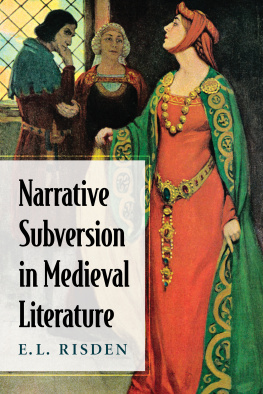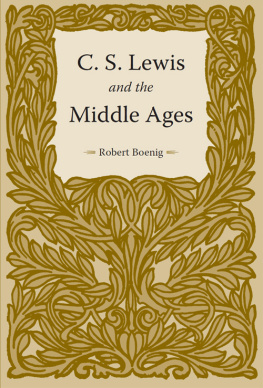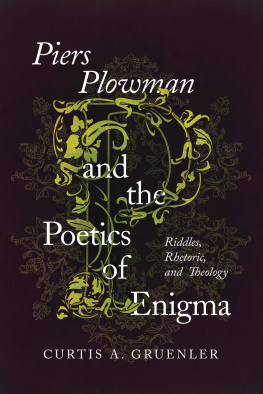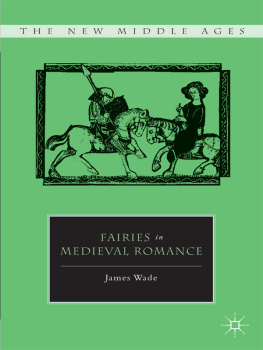
Also by E.L. RISDEN AND FROM MCFARLAND
Tolkiens Intellectual Landscape (2015)
Shakespeare and the Problem Play: Complex Forms, Crossed Genres and Moral Quandaries (2012)
Heroes, Gods and the Role of Epiphany in English Epic Poetry (2008)
EDITED BY E.L. RISDEN
Sir Gawain and the Classical Tradition: Essays on the Ancient Antecedents (2006)
Narrative Subversion in Medieval Literature
E.L. Risden

McFarland & Company, Inc., Publishers
Jefferson, North Carolina
LIBRARY OF CONGRESS CATALOGUING DATA ARE AVAILABLE
BRITISH LIBRARY CATALOGUING DATA ARE AVAILABLE
e-ISBN: 978-1-4766-2586-7
2016 E.L. Risden. All rights reserved
No part of this book may be reproduced or transmitted in any form or by any means, electronic or mechanical, including photocopying or recording, or by any information storage and retrieval system, without permission in writing from the publisher.
Front cover image 2016 PhotoDisc
McFarland & Company, Inc., Publishers
Box 611, Jefferson, North Carolina 28640
www.mcfarlandpub.com
Acknowledgments
Thanks to Mary Paplham for considerable help preparing the manuscript and to Stefan Hall for expert help with the bibliography for Chapter 5. Parts of the manuscript have appeared in the following publications: earlier versions of Chapters 1, 7, and 8 appeared in Enarratio (the journal of the Medieval Association of the Midwest, in numbers 13, 16, and 7, respectively); part of Chapter 3 appeared in the appendix to Beowulf: A Translation for Students (Witan Publishing); part of Chapter 9 is from Shakespeare and the Problem Play 2012 E.L. Risden by permission of McFarland.
PrefaceNarrative Subversion
A Step Toward a Simple Theory of Narrative
In recent years narratology has gained impetus as a growing subset of literary studies. It has attracted considerable interest among scholars and critics of various theoretical persuasions, has even generated a journal of its own, and has in the breadth of its applications acquired nearly a life of its own. Scholars and creative writers have much more yet to say about it, perhaps the main tool in the literary box. For this study Id like to suggest that for a narrative to workthat is, for it to generate pleasure and continuing interestit must use at least one and probably many subversions. Subversion is perhaps the single most powerful and persistent narrative technique.
A narrative subversion creates a sub-version, or at least one potential sub-version, of a story. A teller or writer can create any number of subversions within a narrative, allowing for infinitely many potential story lines. Once an implied trajectory of narrative undergoes a subversion, the new direction of the narrative becomes, at least for a time, the main version, even a super-versionthe narrative overtop other potential sub-versionsuntil the author or narrator decides to subvert the course of the narrative again, once again turning it under, moving it from what it had suggested to something new, something veiled, chiaroscuro, until a main narrative emerges as full and followable. In Tristram Shandy Laurence Sterne famously used humorous subversions, a long series of them, never getting to any sort of full story of the eponymous character. The act of subversion had become the purpose, the result, the impetus of a narrative going nowhere but more deeply into the cavern of itself with no drive or intention to come out again: the voice, the thoughts, the humor, not the plot, became the goal.
The kind of subversion and where it leads tells us something, then, about the story. A mystery may sub-vert as a detective follows various leads and suspects, clues, red herrings, illuminations, until a solution appearsor it may subvert its genre entirely by reaching no solution. It may find the solution and nullify it, as in Umberto Ecos The Name of the Rose, with the unearthing of a manuscript only to have it then destroyed by fire.
Subversion works a little but not exactly like Mieke Bals text interference, but it implies not only a disjunction between actor and narrator (52); it is a little like Friedrich Schlegels idea of irony as permanent parabasis as discussed by J. Hillis Miller, a continuous suspension, all along the narrative line, of any single identifiable rational meaning (37), but it applies not only to meaning and implies the lack of a single, unified narrative line; it is a little like Susanna Onega and Jos Landas ideas of narrative intrusiveness and defamiliarization (2), but it does not foreground techniqueit simply uses technique to foreground an unexpected movement in plot. It is simpler than those ideas and more fundamental. In The Law of Genre Jacques Derrida begins satirically with the blank and bland assertion, Genres are not to be mixed. I will not mix genres (202), but he turns instead to the real law of genre as precisely a principle of contamination, a law of impurity, a parasitical economy (206). He calls such inclusive textual miscegenation a phenomenon of edge, borderlines, boundary that can not arise without a fold and the process of enfoldment (216). Fold is a good term for narrative subversion, as it implies something necessary, homey, even comfortable to the reader: any interesting plot must have it, just as a blanket, to keep one warm, must have folds. The strategy may have comfort even when the narrative event brings suspense or terror.
Plots may take many forms: linear, cyclical, episodic, chronological-historical-sagic, recapitulative or spiral, eschatological, monomythic, biographical/autobiographical (with personal reflection rather than narrative as focus), allegorical, framed, epistolaryjust to name a few. Narrative implies pattern, so we are necessarily considering a structuralist poetics, in this case not imposing a structure on a text, but looking at structures in texts, searching for an Elementary Particle, the basic building-block element or move that a story structure must have to work. Im not considering a list of instructions for the assembly of a safe and sturdy office chair, though the idea may apply to a grocery list. Subverting assembly instructions may lead to the failure of the chair and so perhaps even an injury. The grocery list may plot my way through the store where I shop: peaches, bell peppers, red lettuce, organic milk, eggs, yogurt, butter, fish, bagels, frozen peas, coffee ice cream, black beans, olive oil, mustard, peanut butter, paper towels, light bulbs, bath soap, and some lactose-free milk for the catthen to the cashier. But any number of problems, preferences, or events may subvert my course. But subversions interrupt my quick shopping trip. The peaches are old and soft, so I will get pears in the next aisle instead. I hadnt realized I was thinking of yellow bell peppers, and they have only green and redthe red look better. Only one gallon left of organic skim: they must be selling lots of it now. Theyre out of my favorite yogurt: try a new brand, get the one my wife doesnt like, or skip it for the next trip? The only fish that looks good is the salmonwe had that yesterday, but Ill get it anyway since it was (and is) fresh and very good. Blueberry bagels: maybe too sweet. The guy at the meat counter stops me to talk about Sundays football game. Were both optimistic. Better skip the ice cream, as I would do well to lose a couple poundsthough as I look at it, it seems to me almost irresistible. I resist on principle. Theyre out of Extra Crunchy peanut buttera different brand will do. Oops: forgot to put cereal on the list, but better get it anyway: bran flakes and fruit-and-grain medley. Only large packages of bath soapno problem, since we have room to store the extra. Cashier asks if I found everything I neededdid I forget anything (batteries, bread, broccolino, have all that at home). A series of events with brief and largely inconsequential subversions: typical shopping adventure. The end came out almost as I expected. Not a very interesting plot, but still a series of eventslargely predictable: predictability can be all right sometimes.
Next page











